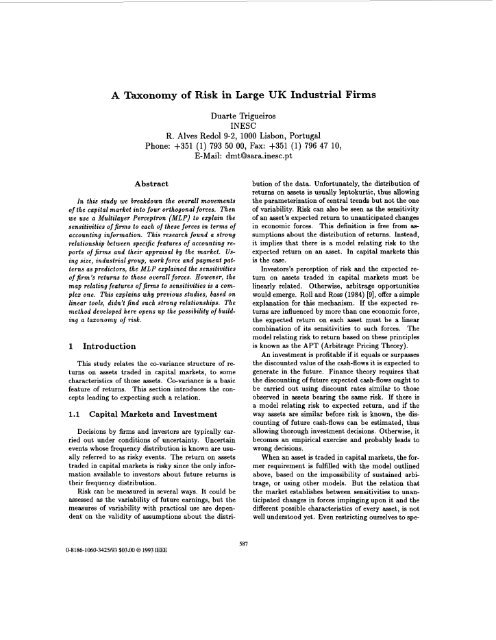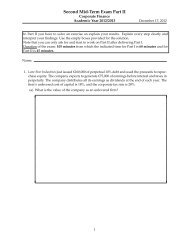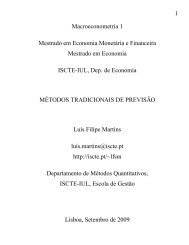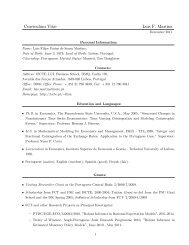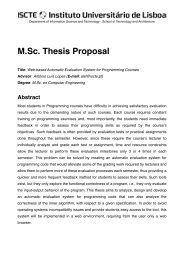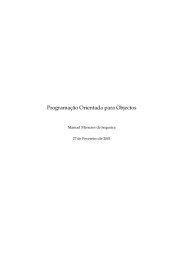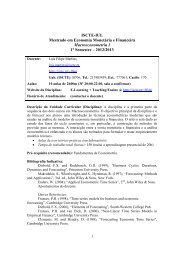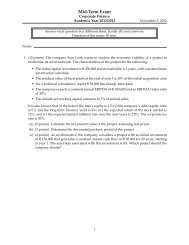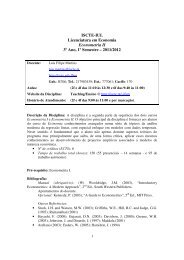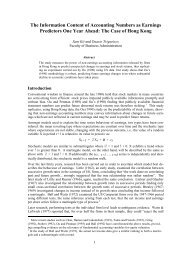A taxonomy of risk in large UK industrial firms
A taxonomy of risk in large UK industrial firms
A taxonomy of risk in large UK industrial firms
You also want an ePaper? Increase the reach of your titles
YUMPU automatically turns print PDFs into web optimized ePapers that Google loves.
A Taxonomy <strong>of</strong> Risk <strong>in</strong> Large <strong>UK</strong> Industrial Firms<br />
Duarte Trigueiros<br />
INESC<br />
R. Alves Redo1 9-2, 1000 Lisbon, Portugal<br />
Phone: +351 (1) 793 50 00, Fax: +351 (1) 796 47 10,<br />
E-Mail: dmt@sara.<strong>in</strong>esc.pt<br />
Abstract<br />
In this study we breakdown the overall movements<br />
<strong>of</strong> the capital market <strong>in</strong>to four orthogonal forces. Then<br />
we use a Multilayer Perceptron (MLP) to expla<strong>in</strong> the<br />
sensitivities <strong>of</strong> <strong>firms</strong> to each <strong>of</strong> these forces <strong>in</strong> terms <strong>of</strong><br />
account<strong>in</strong>g <strong>in</strong>formation. This research found a strong<br />
relationship between specific features <strong>of</strong> account<strong>in</strong>g reports<br />
<strong>of</strong> <strong>firms</strong> and their appraisal by the market. Us<strong>in</strong>g<br />
size, <strong>in</strong>dustrial group, work force and payment patterns<br />
as predictors, the MLP expla<strong>in</strong>ed the sensitivities<br />
<strong>of</strong> firm’s returns to these overall forces. However, the<br />
map relat<strong>in</strong>g features <strong>of</strong> <strong>firms</strong> to sensitivities is a complex<br />
one. This expla<strong>in</strong>s why previous studies, based on<br />
l<strong>in</strong>ear tools, didn’t f<strong>in</strong>d such strong relationships. The<br />
method developed here opens up the possibility <strong>of</strong> build<strong>in</strong>g<br />
a <strong>taxonomy</strong> <strong>of</strong> <strong>risk</strong>.<br />
1 Introduction<br />
This study relates the co-variance structure <strong>of</strong> returns<br />
on assets traded <strong>in</strong> capital markets, to some<br />
characteristics <strong>of</strong> those assets. Co-variance is a basic<br />
feature <strong>of</strong> returns. This section <strong>in</strong>troduces the concepts<br />
lead<strong>in</strong>g to expect<strong>in</strong>g such a relation.<br />
1.1 Capital Markets and Investment<br />
Decisions by <strong>firms</strong> and <strong>in</strong>vestors are typically carried<br />
out under conditions <strong>of</strong> uncerta<strong>in</strong>ty. Uncerta<strong>in</strong><br />
events whose frequency distribution is known are usually<br />
referred to as <strong>risk</strong>y events. The return on assets<br />
traded <strong>in</strong> capital markets is <strong>risk</strong>y s<strong>in</strong>ce the only <strong>in</strong>formation<br />
available to <strong>in</strong>vestors about future returns is<br />
their frequency distribution.<br />
Risk can be measured <strong>in</strong> several ways. It could be<br />
assessed as the variability <strong>of</strong> future earn<strong>in</strong>gs, but the<br />
measures <strong>of</strong> variability with practical use are dependent’<br />
on the validity <strong>of</strong> assumptions about the distri-<br />
bution <strong>of</strong> the data. Unfortunately, the distribution <strong>of</strong><br />
returns on assets is usually leptokurtic, thus allow<strong>in</strong>g<br />
the parameterization <strong>of</strong> central trends but not the one<br />
<strong>of</strong> variability. Risk can also be seen as the sensitivity<br />
<strong>of</strong> an asset’s expected return to unanticipated changes<br />
<strong>in</strong> economic forces. This def<strong>in</strong>ition is free from assumptions<br />
about the distribution <strong>of</strong> returns. Instead,<br />
it implies that there is a model relat<strong>in</strong>g <strong>risk</strong> to the<br />
expected return on an asset. In capital markets this<br />
is the case.<br />
Investors’s perception <strong>of</strong> <strong>risk</strong> and the expected return<br />
on assets traded <strong>in</strong> capital markets must be<br />
l<strong>in</strong>early related. Otherwise, arbitrage opportunities<br />
would emerge. Roll and Ross (1984) [9], <strong>of</strong>fer a simple<br />
explanation for this mechanism. If the expected returns<br />
are <strong>in</strong>fluenced by more than one economic force,<br />
the expected return on each asset must be a l<strong>in</strong>ear<br />
comb<strong>in</strong>ation <strong>of</strong> its sensitivities to such forces. The<br />
model relat<strong>in</strong>g <strong>risk</strong> to return based on these pr<strong>in</strong>ciples<br />
is known as the APT (Arbitrage Pric<strong>in</strong>g Theory).<br />
An <strong>in</strong>vestment is pr<strong>of</strong>itable if it equals or surpasses<br />
the discounted value <strong>of</strong> the cash-flows it is expected to<br />
generate <strong>in</strong> the future. F<strong>in</strong>ance theory requires that<br />
the discount<strong>in</strong>g <strong>of</strong> future expected cash-flows ought to<br />
be carried out us<strong>in</strong>g discount rates similar to those<br />
observed <strong>in</strong> assets bear<strong>in</strong>g the same <strong>risk</strong>. If there is<br />
a model relat<strong>in</strong>g <strong>risk</strong> to expected return, and if the<br />
way assets are similar before <strong>risk</strong> is known, the discount<strong>in</strong>g<br />
<strong>of</strong> future cash-flows can be estimated, thus<br />
allow<strong>in</strong>g thorough <strong>in</strong>vestment decisions. Otherwise, it<br />
becomes an empirical exercise and probably leads to<br />
wrong decisions.<br />
When an asset is traded <strong>in</strong> capital markets, the former<br />
requirement is fulfilled with the model outl<strong>in</strong>ed<br />
above, based on the impossibility <strong>of</strong> susta<strong>in</strong>ed arbitrage,<br />
or us<strong>in</strong>g other models. But the relation that<br />
the market establishes between sensitivities to unanticipated<br />
changes <strong>in</strong> forces imp<strong>in</strong>g<strong>in</strong>g upon it and the<br />
different possible characteristics <strong>of</strong> every asset, is not<br />
well understood yet. Even restrict<strong>in</strong>g ourselves to spe-<br />
0-8186-1060-3425/93 $03.00 0 1993 IEEE<br />
587
cific groups <strong>of</strong> assets like <strong>in</strong>dustries, there is no available<br />
guidance to relate expected returns to the features<br />
<strong>of</strong> assets. As a consequence, it is impossible to<br />
f<strong>in</strong>d out what makes assets similar before <strong>risk</strong>.<br />
This study tries to fill this gap. It shows that it is<br />
possible to build a <strong>taxonomy</strong> <strong>of</strong> <strong>risk</strong>. There is a strong,<br />
though non-l<strong>in</strong>ear, relationship between assets’s characteristics<br />
as perceived by the market and the way<br />
they are traded.<br />
1.2 Non-Diversifiable Risk<br />
Assets are traded by what they are worth <strong>in</strong> the<br />
market’s eyes. But the holders <strong>of</strong> traded assets are<br />
not <strong>risk</strong><strong>in</strong>g their wealth <strong>in</strong> a way that directly relates<br />
to the <strong>risk</strong> <strong>of</strong> each asset they hold. Just by hold<strong>in</strong>g<br />
many assets, <strong>in</strong>vestors smooth out a great deal <strong>of</strong> the<br />
variability <strong>of</strong> their wealth. The only variability they<br />
can’t avoid is the background movement <strong>of</strong> the whole<br />
market.<br />
This background movement is a unique time-history.<br />
But it can be viewed as the result <strong>of</strong> a few orthogonal<br />
forces or “factors’’, each one <strong>of</strong> them captur<strong>in</strong>g<br />
the <strong>large</strong>st dimension <strong>of</strong> the jo<strong>in</strong>t variability <strong>of</strong> returns<br />
on all the traded assets. These factors are obta<strong>in</strong>able<br />
from a representative number <strong>of</strong> time-histories <strong>of</strong> returns,<br />
by decompos<strong>in</strong>g their jo<strong>in</strong>t variability <strong>in</strong>to ma<strong>in</strong><br />
orthogonal co-movements. Each factor is supposed to<br />
be a l<strong>in</strong>ear comb<strong>in</strong>ation <strong>of</strong> economic movements like<br />
Inflation, Industrial Production, Risk Premium <strong>in</strong> the<br />
market, and Interest Rate’s term structure growth.<br />
After Ross’s sem<strong>in</strong>al paper <strong>in</strong> 1976 [lo], the models<br />
us<strong>in</strong>g arbitrage considerations to relate <strong>risk</strong> to return<br />
(the APT), became present <strong>in</strong> the f<strong>in</strong>ance literature<br />
but scarcely <strong>in</strong> the f<strong>in</strong>ance practice. The first signs<br />
<strong>of</strong> their practical use only nowadays seem to emerge.<br />
The reason for this delay may well be the immediate<br />
<strong>in</strong>terest <strong>of</strong> early models, based on one-dimensional<br />
sensitivities to non-diversifiable <strong>risk</strong> (the Betas). It is<br />
clear that, if a thoroughly calculated Beta really expresses<br />
the co-variance <strong>of</strong> an asset’s return with the<br />
whole movement <strong>of</strong> the market, then <strong>in</strong>vestors don’t<br />
need anyth<strong>in</strong>g else. The co-variance with the market<br />
is the only portion <strong>of</strong> an asset’s variability that <strong>in</strong>vestors<br />
will pay to avoid. Thus, it is also the only<br />
piece <strong>of</strong> <strong>in</strong>formation they are likely to pay to know.<br />
However, there are cases <strong>in</strong> which multi-dimensional<br />
models based on arbitrage could become useful<br />
for f<strong>in</strong>ancial practice. Whenever a more precise understand<strong>in</strong>g<br />
<strong>of</strong> the way assets are traded is required, the<br />
APT is the choice. This is the case for the appraisal <strong>of</strong><br />
productive commitments. It is also the case <strong>of</strong> studies<br />
concerned with the market itself.<br />
When search<strong>in</strong>g for a <strong>taxonomy</strong> <strong>of</strong> <strong>risk</strong>, arbitrage<br />
models seem promis<strong>in</strong>g. They are a breakdown <strong>of</strong> an<br />
<strong>in</strong>formation content <strong>in</strong>to features. They should allow<br />
a better discrim<strong>in</strong>ation, each <strong>of</strong> the orthogonal forces<br />
show<strong>in</strong>g particular aff<strong>in</strong>ity towards some aspects <strong>of</strong> assets.<br />
The APT <strong>of</strong>fers the possibility <strong>of</strong> look<strong>in</strong>g onto<br />
an asset’s expected return from several po<strong>in</strong>ts <strong>of</strong> view.<br />
When the emphasis is not <strong>in</strong> the holder but <strong>in</strong> the<br />
asset itself, the APT is the adequate <strong>in</strong>strument for<br />
assess<strong>in</strong>g the variability <strong>of</strong> returns. That’s why it’s<br />
used here.<br />
1.3 Stable and Fluctuat<strong>in</strong>g Features<br />
The hypothesis that the market regards differently<br />
the stable features <strong>of</strong> assets and the more fluctuat<strong>in</strong>g<br />
ones, is a start<strong>in</strong>g-po<strong>in</strong>t <strong>in</strong> our search for a <strong>taxonomy</strong><br />
<strong>of</strong> <strong>risk</strong>.<br />
A rapidly grow<strong>in</strong>g body <strong>of</strong> research documents components<br />
which can be forecasted <strong>in</strong> asset’s returns (see<br />
for example Fama (1988) [4]). It is reasonable to divide<br />
<strong>in</strong>vestors’s movements <strong>in</strong> two categories: Their<br />
expectations, creat<strong>in</strong>g the predictable component <strong>of</strong><br />
returns, and their reaction to unanticipated events,<br />
which creates the unpredictable one. Arbitrage considerations<br />
(the APT) lead to models <strong>in</strong> which sensitivities<br />
to unanticipated economic forces play a role:<br />
Risk is about the second component <strong>of</strong> returns.<br />
The expected component <strong>of</strong> returns ma<strong>in</strong>ly relates<br />
to changes <strong>in</strong> account<strong>in</strong>g numbers. For example, an<br />
<strong>in</strong>crease or decrease <strong>in</strong> Earn<strong>in</strong>gs or Dividends <strong>in</strong>fluence<br />
expectations (see, for example, Brown and Ball,<br />
1967 [2]). However, the features <strong>of</strong> the firm aren’t<br />
equally volatile: There are pieces <strong>of</strong> account<strong>in</strong>g <strong>in</strong>formation<br />
that cannot vary swiftly as they reflect features<br />
<strong>of</strong> the firm that are stable.<br />
We th<strong>in</strong>k that the firm’s stable attributes are the<br />
ones that ma<strong>in</strong>ly create <strong>in</strong> <strong>in</strong>vestors the sensitivity to<br />
unanticipated forces. In fact, only stable features can<br />
create sensitivity: The fluctuat<strong>in</strong>g ones aren’t sensitive<br />
as they move along with the trends. For example,<br />
the <strong>in</strong>dustrial group would expla<strong>in</strong> to some extent the<br />
sensitivity <strong>of</strong> <strong>in</strong>vestors to unexpected movements <strong>of</strong><br />
the economy, because <strong>firms</strong> cannot easily change sector<br />
to face <strong>in</strong>flation or an excess <strong>of</strong> supply. Conversely,<br />
less <strong>in</strong>tr<strong>in</strong>sic features, like the f<strong>in</strong>ancial structure or the<br />
dividend policy, relate to trends and thus to expectations<br />
observed <strong>in</strong> returns.<br />
Hence, this study should search for relations between<br />
the stable features <strong>of</strong> assets and their sensitivities<br />
to market forces. We consider <strong>in</strong>dustry group, location,<br />
size, operat<strong>in</strong>g leverage, labour and capital <strong>in</strong>tensity,<br />
payment pattern (hence, the short-term debt)<br />
588
as candidates for expla<strong>in</strong><strong>in</strong>g market sensitivity. Dividend<br />
policy, capital structure, are less <strong>in</strong>tr<strong>in</strong>sic. Earn<strong>in</strong>gs<br />
could have both components.<br />
1.4 Exist<strong>in</strong>g Research<br />
This study isn’t a replica <strong>of</strong> an exist<strong>in</strong>g one, <strong>in</strong><br />
which an MLP is used <strong>in</strong>stead <strong>of</strong> l<strong>in</strong>ear modell<strong>in</strong>g<br />
tools. It gives a new formulation to an old problem.<br />
Such a formulation is partly possible because <strong>of</strong> the<br />
MLP. It ma<strong>in</strong>ly concerns three areas <strong>of</strong> research: The<br />
search<strong>in</strong>g <strong>of</strong> correlations between characteristics <strong>of</strong> the<br />
firm and <strong>risk</strong>, the build<strong>in</strong>g <strong>of</strong> proxies for Beta based on<br />
acount<strong>in</strong>g <strong>in</strong>formation, and the APT. Foster (1986) [5]<br />
review them.<br />
An early attempt to build a proxy for Beta us<strong>in</strong>g<br />
account<strong>in</strong>g numbers is the one <strong>of</strong> Beaver, Kettler and<br />
Scholes (1970) [l]. They achieved small but significant<br />
correlations between account<strong>in</strong>g and market measures<br />
<strong>of</strong> <strong>risk</strong>. Much research has also been published on the<br />
correlation <strong>of</strong> operat<strong>in</strong>g leverage, gear<strong>in</strong>g, size, with<br />
Beta, the covariance <strong>of</strong> an asset’s expected return with<br />
the background movement <strong>of</strong> the whole market. 30%<br />
is a typical value for the proportion <strong>of</strong> variability <strong>of</strong><br />
returns expla<strong>in</strong>ed by these models.<br />
We would like to underl<strong>in</strong>e the fact that models<br />
like those <strong>of</strong> “Fundamental Analysis” (which assumes<br />
that each asset has an <strong>in</strong>tr<strong>in</strong>sic value that can be determ<strong>in</strong>ed<br />
on the basis <strong>of</strong> earn<strong>in</strong>gs, dividends, capital<br />
structure and potential growth) or “Equity Valuation”<br />
(which focus on predicted earn<strong>in</strong>gs and dividends), are<br />
not the k<strong>in</strong>d <strong>of</strong> relation we are <strong>in</strong>terested <strong>in</strong> here. Such<br />
models calculate <strong>in</strong>dexes reflect<strong>in</strong>g trends observed <strong>in</strong><br />
<strong>in</strong>dividual histories <strong>of</strong> <strong>firms</strong> and use them to expla<strong>in</strong><br />
the market reaction to the performance <strong>of</strong> those <strong>firms</strong>.<br />
S<strong>in</strong>ce we focus on <strong>risk</strong>, that is, the unanticipated components<br />
<strong>of</strong> returns, we are not try<strong>in</strong>g to forecast returns<br />
or other <strong>in</strong>dexes.<br />
2 Prelim<strong>in</strong>ary Process<strong>in</strong>g <strong>of</strong> Data<br />
This study br<strong>in</strong>gs together two sources <strong>of</strong> data.<br />
Firstly, a <strong>large</strong> set <strong>of</strong> time-histories <strong>of</strong> returns on assets<br />
traded <strong>in</strong> the London Stock Exchange, from which sensitivities<br />
<strong>of</strong> a few <strong>of</strong> them to four orthogonal forces are<br />
extracted. Secondly, the collection <strong>of</strong> account<strong>in</strong>g reports<br />
<strong>of</strong> the assets whose sensitivities were extracted.<br />
The sensitivities are the ones we use <strong>in</strong> the next section<br />
as target or expla<strong>in</strong>ed variables, both <strong>in</strong> the MLP<br />
and <strong>in</strong> l<strong>in</strong>ear regressions. The account<strong>in</strong>g data will be<br />
used as <strong>in</strong>put.<br />
2.1 Time-Histories <strong>of</strong> Returns<br />
The assets selected for extract<strong>in</strong>g sensitivities were<br />
listed <strong>in</strong> the FTA All Shares Index. The reason for<br />
us<strong>in</strong>g only listed <strong>firms</strong> relates to the decision <strong>of</strong> avoid<strong>in</strong>g<br />
<strong>in</strong>frequently traded assets. The known means for<br />
circumvent<strong>in</strong>g the problems posed by <strong>in</strong>frequent trad<strong>in</strong>g<br />
[3] would <strong>in</strong>troduce <strong>in</strong> our experiment an extra<br />
manipulation <strong>of</strong> <strong>in</strong>formation. For the same reason,<br />
the use <strong>of</strong> daily or weekly returns was discarded. We<br />
used monthly returns provided by the London Bus<strong>in</strong>ess<br />
School, spann<strong>in</strong>g a period <strong>of</strong> 15 years, from January<br />
1974 to December 1988. Returns were calculated<br />
as<br />
Industry * * b I Industry N . b<br />
Build<strong>in</strong>g - Materials I 11 I El ectronics I 9<br />
Paper and Pack<strong>in</strong>g<br />
Chemicals<br />
Electrical<br />
rt = log, (-) Pt + dt<br />
Pt-1<br />
<strong>in</strong> which pt stands for traded price <strong>in</strong> month t, pt-l<br />
is the last traded price <strong>in</strong> month t - 1 and d* is the<br />
dividend declared adjusted to a month-end basis. All<br />
adjustments were based on the pr<strong>in</strong>ciple that the value<br />
<strong>of</strong> a share is unaltered by a change <strong>in</strong> capital structure.<br />
We used a total <strong>of</strong> 121 time-histories <strong>of</strong> assets for<br />
the extraction <strong>of</strong> sensitivities. All <strong>of</strong> them were <strong>in</strong>dustries.<br />
Included <strong>in</strong> these 121 <strong>firms</strong> were the 77 ones<br />
whose account<strong>in</strong>g reports were to be related to their<br />
sensitivities. The selection <strong>of</strong> the 77 f<strong>in</strong>al <strong>firms</strong> was<br />
made on an <strong>in</strong>dustry basis. Only seven <strong>in</strong>dustries were<br />
selected. S<strong>in</strong>ce one <strong>of</strong> our goals was the assessment <strong>of</strong><br />
the effect <strong>of</strong> <strong>in</strong>dustrial group<strong>in</strong>g, it didn’t seem appropriate<br />
to gather <strong>in</strong> the same sample a <strong>large</strong> number <strong>of</strong><br />
<strong>in</strong>dustries. The selected ones were:<br />
10 Textiles 10<br />
15 FoodManuf. 13<br />
9<br />
All companies quoted on the London Stock Exchange<br />
are classified <strong>in</strong>to <strong>in</strong>dustrial groups accord<strong>in</strong>g<br />
to the Stock Exchange Industrial Classification<br />
(SEIC). The above groups refer to the SEIC.<br />
Given the returns <strong>of</strong> 121 <strong>in</strong>dustries dur<strong>in</strong>g the referred<br />
period, a Factor Analysis was performed on<br />
their time-history taken as stochastic variables. The<br />
aim was to rotate the co-variance matrix so that a<br />
few m<strong>in</strong>imum co-variance axis would emerge. Thus,<br />
we obta<strong>in</strong>ed a breakdown <strong>of</strong> the cross-correlation <strong>of</strong><br />
time-histories <strong>in</strong>to its four ma<strong>in</strong> components. In order<br />
to ma<strong>in</strong>ta<strong>in</strong> comparability with other APT studies we<br />
used Maximum-Likelihood as the criterion for the extraction<br />
<strong>of</strong> factors.<br />
The result<strong>in</strong>g factors are supposed to be a l<strong>in</strong>ear<br />
comb<strong>in</strong>ation <strong>of</strong> a few economic forces imp<strong>in</strong>g<strong>in</strong>g upon<br />
589
the market. In our case the four ma<strong>in</strong> factors expla<strong>in</strong>ed<br />
47% <strong>of</strong> the variability <strong>of</strong> returns. Their Eigenvalues<br />
(<strong>in</strong> percent <strong>of</strong> the expla<strong>in</strong>ed variability) are:<br />
39.5 0<br />
42.5%<br />
2.4% 44.9%<br />
2.0% 46.9%<br />
Sensitiv. to<br />
Force N.<br />
1<br />
2<br />
3<br />
4<br />
Skewness Kurtosis Mean St. Dev.<br />
-0.88 -0.12 0.412 0.189<br />
-0.48 0.19 0.269 0.124<br />
0.40 0.60 0.263 0.148<br />
1.88 1.03 0.184 0.126<br />
Figure 1: The first factor’s sensitivities (Y-axis)<br />
aga<strong>in</strong>st U,, the relative size <strong>of</strong> <strong>firms</strong> (X-axis).<br />
prices on the Paper <strong>in</strong>dustry. It is also very <strong>in</strong>fluential<br />
for the Food <strong>in</strong>dustry, but <strong>in</strong> the opposite direction.<br />
Factor 2 has a positive <strong>in</strong>fluence <strong>in</strong> Food Manufacturers<br />
and Electronics. It has a negative or no effect on<br />
the other <strong>in</strong>dustries. Factor 3 has a strong, negative,<br />
<strong>in</strong>fluence on the Electronics <strong>in</strong>dustry. It is a positive<br />
one for Food Manufacturers and Paper.<br />
We also observed the correlations between the communality<br />
associated with each firm, their load<strong>in</strong>gs and<br />
some features <strong>of</strong> these <strong>firms</strong>. The communality measures<br />
the portion <strong>of</strong> variability <strong>of</strong> returns that are<br />
expla<strong>in</strong>ed by the factors. In our sample, it clearly<br />
relates to Size and Earn<strong>in</strong>gs. This means that the<br />
<strong>large</strong>st <strong>firms</strong> and the most pr<strong>of</strong>itable ones are also the<br />
ones traded <strong>in</strong> a more similar, predictable, way. An<br />
<strong>in</strong>terest<strong>in</strong>g study related to this issue is Roll’s “R2”<br />
(1988) [8]. It is an empirical assessment <strong>of</strong> the variability<br />
expla<strong>in</strong>ed <strong>in</strong> stock returns by the market models.<br />
Roll correlates the collection <strong>of</strong> R2 observed <strong>in</strong> several<br />
k<strong>in</strong>ds <strong>of</strong> market models with a few characteristics <strong>of</strong><br />
the firm.<br />
Scatter-plots <strong>of</strong> features <strong>of</strong> <strong>firms</strong> aga<strong>in</strong>st their sensitivities<br />
were also observed as part <strong>of</strong> this prelim<strong>in</strong>ary<br />
study. Correlations were observed between Size and<br />
the first two factor’s sensitivities. The correlation between<br />
Size and the first one is non-l<strong>in</strong>ear (see figure 1<br />
on page 4). The second one exhibits a negative, l<strong>in</strong>ear,<br />
correlation with size but <strong>in</strong>dustrial groups form<br />
visible clusters. Also Gross Funds From Operations<br />
and Inventory show significant correlation with some<br />
sensitivities.<br />
2.2 Account<strong>in</strong>g Reports<br />
Factor 1<br />
35.4%<br />
Factor 2 Factor 3 Factor 4<br />
39.9% 43.1% 3.4%<br />
Us<strong>in</strong>g the convention <strong>of</strong> call<strong>in</strong>g “positive” to <strong>in</strong>fluences<br />
which are above the expected and “negative”<br />
otherwise, we can say that Factor 1 strongly <strong>in</strong>fluences<br />
Account<strong>in</strong>g raw data, as found <strong>in</strong> databases conta<strong>in</strong><strong>in</strong>g<br />
collections <strong>of</strong> annual reports <strong>of</strong> <strong>firms</strong>, can be<br />
viewed as statistical variables. Each firm is a case. For<br />
a given item, say, Fixed Assets or Sales, a collection<br />
<strong>of</strong> reports from the same year forms a cross-sectional<br />
sample. The probability density function govern<strong>in</strong>g<br />
590
such variables is the lognormal one. Items belong<strong>in</strong>g<br />
to the same report share, <strong>in</strong> cross-section, most <strong>of</strong><br />
their variability. This is caused by the prevalent effect<br />
<strong>of</strong> size. Size is an important piece <strong>of</strong> <strong>in</strong>formation<br />
but its effect isn't directly measurable. However, it is<br />
possible to isolate it by build<strong>in</strong>g, <strong>in</strong>side each report,<br />
averages <strong>of</strong> a few positive-valued items like Net Worth,<br />
Wages or Sales. In this way, we self-smooth the particular<br />
scatter <strong>of</strong> each item so that only the common<br />
one rema<strong>in</strong>s.<br />
Thus, consider<strong>in</strong>g a group <strong>of</strong> account<strong>in</strong>g items,<br />
zf , i = 1, M, from the jth report, we expla<strong>in</strong> their variability<br />
as the result <strong>of</strong> an effect, uj , common to them<br />
all, plus the residuals, E:, particular to each item:<br />
log.; - p1 = uj +E;<br />
10gzj - p2 = uj + Ej<br />
logx -pM<br />
= uj +E<br />
The pi are the expected values <strong>of</strong> logz'. The average<br />
<strong>of</strong> the 1,. . . , i, . .-, M mean-adjusted items case<br />
by case yields, for report j ,<br />
. M<br />
1 1<br />
M<br />
uj = - C(l0gzj -pi) - +€; +. ..+E)<br />
i=l<br />
S<strong>in</strong>ce an average <strong>of</strong> <strong>in</strong>dependent random deviates<br />
tends to zero with 1/M,<br />
Gr. Fundsfr. Operat. NW Net Worth<br />
CA Current Assets Current Liabil.<br />
Inventory<br />
Sales<br />
Number <strong>of</strong> Empl. W Wages<br />
Table 1: List <strong>of</strong> account<strong>in</strong>g items used <strong>in</strong> this study<br />
and their abbreviations.<br />
denom<strong>in</strong>ator is the statistical effect <strong>of</strong> size and the<br />
numerator is the deviation <strong>of</strong> item i from the standard<br />
<strong>in</strong> its <strong>in</strong>dustry. Such ratios reflect the proportion to<br />
which the item <strong>in</strong> the numerator departures from the<br />
expected for <strong>firms</strong> <strong>of</strong> that size. That is, the are<br />
size-adjusted Sales, Work<strong>in</strong>g Capital and so on. Apart<br />
from render<strong>in</strong>g Gaussian <strong>in</strong>puts, the use <strong>of</strong> log space<br />
makes the similar to proportions: The deviations<br />
from size they assess are <strong>in</strong>dependent <strong>of</strong> scale and unit<br />
<strong>of</strong> measure.<br />
3 TheMethod<br />
We modelled sensitivities <strong>in</strong> terms <strong>of</strong> account<strong>in</strong>g <strong>in</strong>formation,<br />
firstly us<strong>in</strong>g l<strong>in</strong>ear regressions and then the<br />
MLP. In both cases the tra<strong>in</strong><strong>in</strong>g sets were the same.<br />
S<strong>in</strong>ce the four targets are almost orthogonal there is<br />
noth<strong>in</strong>g to be ga<strong>in</strong>ed from show<strong>in</strong>g them jo<strong>in</strong>tly to<br />
the modell<strong>in</strong>g tool. Hence, we built four <strong>in</strong>dependent<br />
MLPs, each one for expla<strong>in</strong><strong>in</strong>g one sensitivity.<br />
3.1 Input Variables<br />
for <strong>large</strong> enough M. Once obta<strong>in</strong>ed, U allows the assessment<br />
<strong>of</strong> the ci particular to each item:<br />
E: =logzf.-pi-uj (1)<br />
In this study, the estimated U was obta<strong>in</strong>ed as<br />
U = $[logs + log NW + logW + logN<br />
+ log D + log CA + log CL]<br />
(2)<br />
The mean<strong>in</strong>g <strong>of</strong> the abbreviations can be found <strong>in</strong> table<br />
l. The log items were mean-adjusted separately by<br />
<strong>in</strong>dustry and by year before be<strong>in</strong>g used <strong>in</strong> formula (2).<br />
Thus, the <strong>in</strong>dustry and year effects aren't present <strong>in</strong><br />
these variables. A more detailed characterisation <strong>of</strong><br />
the statistical behaviour <strong>of</strong> account<strong>in</strong>g data can be<br />
found <strong>in</strong> Trigueiros (1992) [15].<br />
We used the E ~ along , with our proxy for size, the<br />
uj, as <strong>in</strong>put variables to expla<strong>in</strong> sensitivities. Notice<br />
that the E" are the logarithm <strong>of</strong> ratios <strong>in</strong> which the<br />
Table 2 on page 7 shows the 17 <strong>in</strong>put variables used<br />
both <strong>in</strong> the l<strong>in</strong>ear regressions and <strong>in</strong> the MLP. N<strong>in</strong>e <strong>of</strong><br />
them are the E ~ obta<strong>in</strong>ed , from apply<strong>in</strong>g formula (1)<br />
to account<strong>in</strong>g items. One is our proxy for size, the<br />
U,, as calculated by formula (2). The rema<strong>in</strong><strong>in</strong>g seven<br />
are dummy variables tak<strong>in</strong>g the value 1 when a case<br />
belongs to a particular <strong>in</strong>dustry and 0 otherwise.<br />
The selection <strong>of</strong> the set <strong>of</strong> n<strong>in</strong>e items was a result<br />
<strong>of</strong> an exploratory study, similar to the one presented<br />
here but <strong>in</strong>volv<strong>in</strong>g a <strong>large</strong>r number <strong>of</strong> items and different<br />
topologies. The penalization <strong>of</strong> small weights,<br />
to be described <strong>in</strong> section 3.2, allowed the elim<strong>in</strong>ation<br />
<strong>of</strong> non-significant <strong>in</strong>put variables.<br />
The account<strong>in</strong>g data were drawn from the Micro-<br />
EXSTAT database <strong>of</strong> company f<strong>in</strong>ancial <strong>in</strong>formation<br />
provided by EXTEL Statistical Services Ltd, which<br />
covers the top 70% <strong>of</strong> <strong>UK</strong> <strong>in</strong>dustrial companies. As<br />
mentioned above, we used the reports <strong>of</strong> 77 <strong>firms</strong><br />
match<strong>in</strong>g the selected sensitivities. For each firm,<br />
four years <strong>of</strong> account<strong>in</strong>g reports were collected: 1983<br />
59 1
Figure 2: Schematic representation <strong>of</strong> the used MLP.<br />
to 1986. Each example <strong>in</strong> the tra<strong>in</strong><strong>in</strong>g set conta<strong>in</strong>s<br />
the accounts <strong>of</strong> one firm for one <strong>of</strong> these years and<br />
hav<strong>in</strong>g as target one sensitivity. Therefore, there are<br />
77 x 4 = 308 examples.<br />
3.2 The MLP<br />
In many MLP applications the problem is one <strong>of</strong><br />
classification. In this case it was one <strong>of</strong> regression.<br />
The only difference, <strong>in</strong> what concerns the MLP, is that<br />
l<strong>in</strong>ear transfer functions must be used <strong>in</strong> the output<br />
layer <strong>of</strong> nodes and that the adequate success criterion<br />
is Least-Squares m<strong>in</strong>imization, not Likelihood maximization.<br />
The topology <strong>of</strong> the MLP and the <strong>in</strong>put variables<br />
were similar <strong>in</strong> the four cases (see a schematic representation<br />
<strong>in</strong> figure 2). There were 17 <strong>in</strong>put nodes,<br />
correspond<strong>in</strong>g to 17 <strong>in</strong>put variables. The unique hidden<br />
layer had four nodes and the output layer had a<br />
l<strong>in</strong>ear transfer function. This topology seems austere.<br />
But s<strong>in</strong>ce the number <strong>of</strong> cases <strong>in</strong> the tra<strong>in</strong><strong>in</strong>g set was<br />
small, the number <strong>of</strong> parameters <strong>in</strong> the models had to<br />
be small as well. The characteristics which make our<br />
MLP different from the standard algorithm (Rumelhart<br />
et all. 1986 [ll]) can be summarized as:<br />
e The use <strong>of</strong> two samples, one to learn and another<br />
one to assess the classification performance, along<br />
with <strong>in</strong>complete tra<strong>in</strong><strong>in</strong>g.<br />
e Penalization <strong>of</strong> small weights, as described by Trigueiros<br />
and Berry (1991) [16].<br />
e Learn<strong>in</strong>g rates particular to each weight as described<br />
<strong>in</strong> Silva and Almeida (1990) [12].<br />
We now comment on these characteristics. The first<br />
one relates to improvements <strong>in</strong> the ability to generalise.<br />
It is a particular implementation <strong>of</strong> a known<br />
procedure, the Cross-Validation (see Stone 1978 [14]).<br />
In order to obta<strong>in</strong> an estimate <strong>of</strong> the generalisation<br />
capacity <strong>of</strong> a model, the orig<strong>in</strong>al samples were divided<br />
randomly <strong>in</strong>to two sub-samples. Models were constructed<br />
with one sub-sample, the tra<strong>in</strong><strong>in</strong>g set, and<br />
a check carried out with the other one, the test set.<br />
S<strong>in</strong>ce the outcomes were cont<strong>in</strong>uous-valued, the adequate<br />
measure <strong>of</strong> quality <strong>of</strong> fitt<strong>in</strong>g was the proportion<br />
<strong>of</strong> expla<strong>in</strong>ed variability, R2, corrected for the degrees<br />
<strong>of</strong> freedom engaged. All reported results concern the<br />
test set, not the tra<strong>in</strong><strong>in</strong>g set. That is, they were obta<strong>in</strong>ed<br />
by measur<strong>in</strong>g the rate <strong>of</strong> expla<strong>in</strong>ed variability<br />
<strong>in</strong> the half-set not used for tra<strong>in</strong><strong>in</strong>g. The performance<br />
on the set used for tra<strong>in</strong><strong>in</strong>g depends solely on the number<br />
<strong>of</strong> free parameters and can be <strong>in</strong>creased simply by<br />
<strong>in</strong>troduc<strong>in</strong>g more nodes on the net. Therefore such<br />
results are un<strong>in</strong>terest<strong>in</strong>g.<br />
The randomization lead<strong>in</strong>g to the division <strong>in</strong>to two<br />
samples - the test and the tra<strong>in</strong><strong>in</strong>g set - was carried<br />
out by <strong>firms</strong> on an <strong>in</strong>dustry basis. Thus, the two<br />
result<strong>in</strong>g groups <strong>of</strong> <strong>firms</strong> didn’t yield <strong>large</strong> differences<br />
<strong>in</strong> their proportion <strong>of</strong> cases for each <strong>in</strong>dustry. The<br />
tra<strong>in</strong><strong>in</strong>g set conta<strong>in</strong>ed 213 <strong>of</strong> the <strong>firms</strong>.<br />
S<strong>in</strong>ce the MLP seeks an optimum iteratively, we<br />
can stop its tra<strong>in</strong><strong>in</strong>g when an optimum is obta<strong>in</strong>ed<br />
<strong>in</strong> the test set rather than <strong>in</strong> the tra<strong>in</strong><strong>in</strong>g set. We<br />
thus prevent this powerful algorithm from over-fitt<strong>in</strong>g<br />
the data. The Back-Propagation algorithm seeks the<br />
modell<strong>in</strong>g <strong>of</strong> progressively smaller or less important<br />
features <strong>of</strong> the relation, dur<strong>in</strong>g the learn<strong>in</strong>g process.<br />
Firstly, broad features are accounted for: The mean,<br />
a l<strong>in</strong>ear trend. Then, more detailed ones are modelled.<br />
Hence, the effective degrees <strong>of</strong> freedom the MLP engages<br />
can be viewed as <strong>in</strong>creas<strong>in</strong>g dur<strong>in</strong>g learn<strong>in</strong>g. Assum<strong>in</strong>g<br />
that the topology <strong>of</strong> the net conta<strong>in</strong>s plenty <strong>of</strong><br />
free parameters, the MLP will be able to model, not<br />
only the desired features but also the undesirable random<br />
uniqueness <strong>of</strong> a particular sample. We prevent<br />
it from do<strong>in</strong>g this by stopp<strong>in</strong>g the process before f<strong>in</strong>ish<strong>in</strong>g.<br />
The appropriate moment for stopp<strong>in</strong>g is when<br />
the results, as measured by the test set, are optimal.<br />
For a good topology, the fact that the learn<strong>in</strong>g stops<br />
before a m<strong>in</strong>imum is reached <strong>in</strong> the learn<strong>in</strong>g set clearly<br />
enhances generalisation.<br />
F<strong>in</strong>ally, we <strong>in</strong>troduced dur<strong>in</strong>g tra<strong>in</strong><strong>in</strong>g a penalization<br />
<strong>of</strong> weights smaller than 1 <strong>in</strong> order to enhance <strong>in</strong>terpretability.<br />
If the <strong>in</strong>put variables were very differently<br />
scaled, weights smaller than 1 could just mean<br />
that the MLP was try<strong>in</strong>g to scale down a particular<br />
variable. S<strong>in</strong>ce the <strong>in</strong>put to the MLP are meanadjusted<br />
and have similar standard deviations, the<br />
only reason for any such weights to rema<strong>in</strong> small<br />
throughout the learn<strong>in</strong>g is to try to dim<strong>in</strong>ish the importance<br />
<strong>of</strong> one variable to the output <strong>of</strong> the node it<br />
592
Input variable<br />
Chemical<br />
Electronics<br />
Size )<br />
Textiles (d-y 1<br />
Wages<br />
(e:)<br />
Current Assets (E: 1<br />
Debtors<br />
(cl)<br />
Electrical<br />
(dummy)<br />
Net Worth (E’ 1<br />
Paper and Pack<strong>in</strong>g<br />
Build<strong>in</strong>g Materials<br />
Sales<br />
(e’)<br />
Fixed Assets (E’ )<br />
Food Manufacturers (d-y)<br />
Gross Funds From Ops. (E’)<br />
Debt<br />
(E’)<br />
Inventory (4<br />
Number <strong>of</strong> parameters engaged Total<br />
Model 1 Model 2 Model 3 Model 4<br />
3 1 1 1 6<br />
2 3 1 6<br />
2 2 2 6<br />
2 2 2 6<br />
3 1 2 6<br />
3 1 1 5<br />
2 1 2 5<br />
1 1 2 1 5<br />
3 1 1 5<br />
3 1 1 5<br />
3 1 4<br />
1 2 3<br />
1 1 2<br />
1 1 2<br />
1 1 2<br />
1 1<br />
1 1<br />
Table 2: The number <strong>of</strong> parameters (first hidden layer) engaged dur<strong>in</strong>g the tra<strong>in</strong><strong>in</strong>g <strong>of</strong> the four MLP, by <strong>in</strong>put.<br />
belongs to. In the MLP, each node acts as a modell<strong>in</strong>g<br />
unit with a certa<strong>in</strong> amount <strong>of</strong> free parameters. The<br />
same output can be obta<strong>in</strong>ed with very different comb<strong>in</strong>ations<br />
<strong>of</strong> weights. Small weights connect<strong>in</strong>g <strong>in</strong>puts<br />
with the first hidden layer appear when a node tries<br />
to weaken the contribution <strong>of</strong> a variable. If we <strong>in</strong>troduce<br />
a penalization <strong>of</strong> such weights dur<strong>in</strong>g the tra<strong>in</strong><strong>in</strong>g,<br />
as the correction <strong>of</strong> weights is proportional to the<br />
<strong>in</strong>put variables, small weights tend to rema<strong>in</strong> small.<br />
In the same way, <strong>large</strong> weights tend to have their values<br />
strengthen. The f<strong>in</strong>al result is a contrasted set <strong>of</strong><br />
weights: The first layer now conta<strong>in</strong>s only very <strong>large</strong><br />
or very small weights. The <strong>in</strong>formation concern<strong>in</strong>g<br />
the modelled relation is concentrated <strong>in</strong> a few weights<br />
<strong>in</strong>stead <strong>of</strong> distributed by all <strong>of</strong> them [16].<br />
Notice that we never tried this method with the<br />
simple Back-Propagation. Each one <strong>of</strong> the weights <strong>in</strong><br />
our MLP has its own <strong>in</strong>crement, adjusted as described<br />
<strong>in</strong> Silva and Almeida (1990) [12]. Other popular methods<br />
for prun<strong>in</strong>g the MLP are the “Skeletonization” [7]<br />
and “Optimal Bra<strong>in</strong> Damage” [6]. However, the first<br />
one is <strong>in</strong>tended to reduce the number <strong>of</strong> nodes, not<br />
the one <strong>of</strong> weights. The second one is too general for<br />
this task.<br />
4 The MLP Versus L<strong>in</strong>ear Regression<br />
Table 2 shows, for each one <strong>of</strong> the four models, the<br />
number <strong>of</strong> non-zero weights <strong>in</strong> the first hidden layer,<br />
when the tra<strong>in</strong><strong>in</strong>g f<strong>in</strong>ished. The rema<strong>in</strong><strong>in</strong>g ones were<br />
set to zero by the algorithm described above and play<br />
no role <strong>in</strong> the modell<strong>in</strong>g. The non-zero weights are the<br />
parameters <strong>of</strong> the first hidden layer engaged dur<strong>in</strong>g<br />
the tra<strong>in</strong><strong>in</strong>g <strong>of</strong> the MLP. S<strong>in</strong>ce the number <strong>of</strong> nodes <strong>in</strong><br />
the first hidden layer was four, the maximum number<br />
<strong>of</strong> parameters per <strong>in</strong>put variable that the MLP could<br />
engage <strong>in</strong> the modell<strong>in</strong>g process would be four as well.<br />
This never happened. The tra<strong>in</strong><strong>in</strong>g started with 68<br />
free parameters and f<strong>in</strong>ished with 29 rema<strong>in</strong><strong>in</strong>g ones<br />
(the first model), 20 (the second), 9 (the third), and<br />
12 (the fourth).<br />
The number <strong>of</strong> parameters engaged is a rough measure<br />
<strong>of</strong> the complexity <strong>of</strong> the relation. Size and Wages<br />
engage a total <strong>of</strong> six parameters. Debt and Inventory<br />
merely engage one. In general, the dummy variables<br />
engage more parameters than items. Next table compares<br />
the proportion <strong>of</strong> variability, R2, expla<strong>in</strong>ed by<br />
all models, when us<strong>in</strong>g l<strong>in</strong>ear regressions (OLS) and<br />
the MLP.<br />
R’ I Model1 I Model2 I Model3 I Model4<br />
MLP I 71% I 48% I 69% I 36%<br />
I OLS I 60% I 42% I 52% I 21% I<br />
The compar<strong>in</strong>g <strong>of</strong> the R2 achieved by the MLP with<br />
those <strong>of</strong> l<strong>in</strong>ear regressions lead us to conclude that the<br />
MLP made a significant improvement <strong>in</strong> captur<strong>in</strong>g the<br />
relation. In next section we shall see why: Such a<br />
relation conta<strong>in</strong>s higher order effects and other sources<br />
<strong>of</strong> complexity.<br />
5 Explor<strong>in</strong>g the Models<br />
This section describes how the explor<strong>in</strong>g <strong>of</strong> the four<br />
models was carried out. We used an “other th<strong>in</strong>gs be<strong>in</strong>g<br />
equal” approach. It consisted <strong>of</strong> vary<strong>in</strong>g one <strong>of</strong> the<br />
<strong>in</strong>puts at a time, and ma<strong>in</strong>ta<strong>in</strong><strong>in</strong>g all the others fixed<br />
593
n.<br />
05<br />
0.3<br />
Size<br />
0.1<br />
-1.6 -12 na 4.4 0.4 0.8 12 1.6<br />
0.a , 1<br />
0.7<br />
0.6<br />
0.7 1<br />
Gr. Funds<br />
0.3<br />
03<br />
0.1<br />
na<br />
Figure 3: The first factor’s sensitivity to Size (above)<br />
and to Gross Funds From Operations (below) as predicted<br />
by the MLP.<br />
Figure 4: The first factor’s sensitivity to size-adjusted<br />
Current Assets (above) and Debtors (below) as predicted<br />
by the MLP.<br />
<strong>in</strong> their mean values. The observed outputs could then<br />
be compared.<br />
The chosen approach is the only one available <strong>in</strong><br />
this case. The model the MLP yields is far too complicated<br />
for direct <strong>in</strong>terpretation. The used procedure<br />
allows an effective look <strong>in</strong>to what the model<br />
does. However, <strong>in</strong> some cases, the “other th<strong>in</strong>gs be<strong>in</strong>g<br />
equal” technique yields mislead<strong>in</strong>g results s<strong>in</strong>ce the<br />
other th<strong>in</strong>gs cannot rema<strong>in</strong> equal <strong>in</strong> the real world.<br />
We firstly comment on the simplest relations - the<br />
ones which are l<strong>in</strong>ear regard<strong>in</strong>g <strong>in</strong>dustrial group<strong>in</strong>g.<br />
Then, we comment on those cases <strong>in</strong> which the model<br />
shows <strong>in</strong>dustries react<strong>in</strong>g <strong>in</strong> different directions to the<br />
same force.<br />
Figure 3 shows, for a few <strong>in</strong>dustries, the relation<br />
modelled by the MLP when expla<strong>in</strong><strong>in</strong>g the first factor’s<br />
sensitivity to Size (above) and Gross Funds From<br />
Operations (below). Similar patterns were obta<strong>in</strong>ed<br />
for Sales and Long Term Debt (a negative correlation).<br />
Each l<strong>in</strong>e represents an <strong>in</strong>dustrial group. Notice<br />
that, s<strong>in</strong>ce we used size-adjusted items as <strong>in</strong>put<br />
variables (the E ~ formula , l), a value <strong>of</strong> zero means the<br />
expected for <strong>firms</strong> <strong>of</strong> that size. Values <strong>large</strong>r than zero<br />
mean Sales or Gross Funds above the expected.<br />
Electronics is the <strong>in</strong>dustry whose size has the<br />
<strong>large</strong>st sensitivity to the first economic force, while<br />
Build<strong>in</strong>g Materials is the one with the smallest. However,<br />
s<strong>in</strong>ce <strong>in</strong> Factor Analysis the sign <strong>of</strong> the factors is<br />
arbitrary, the displayed curves yield a coherent view<br />
but not one directly comparable with studies based<br />
on correlations with Beta. For example, the trends<br />
we observe <strong>in</strong> the case <strong>of</strong> the first factor are the <strong>in</strong>verse<br />
<strong>of</strong> the ones Beaver, Ketler and Scholes (1970) [l]<br />
obta<strong>in</strong>ed for similar variables.<br />
The first factor rewards positive features <strong>of</strong> the firm<br />
and penalizes Debt. None <strong>of</strong> the displayed curves deserved<br />
from the MLP the engagement <strong>of</strong> many parameters<br />
as these are easy-to-build relations. The second<br />
factor rewards Wages, Debtors and penalizes Earn<strong>in</strong>gs.<br />
But some <strong>in</strong>dustries are more sensitive than others.<br />
Aga<strong>in</strong>, remember that the mean<strong>in</strong>g <strong>of</strong> Wages or<br />
Sales be<strong>in</strong>g <strong>large</strong> is that they are <strong>large</strong> given the size<br />
<strong>of</strong> the firm. The third factor’s sensitivities reward Net<br />
Worth and penalize Fixed Assets. F<strong>in</strong>ally, the fourth<br />
factor’s sensitivities penalize Size and Debtors and reward<br />
Inventory but <strong>in</strong> a non-l<strong>in</strong>ear way.<br />
So far, we described the cases <strong>in</strong> which the sensitivities<br />
<strong>of</strong> all <strong>in</strong>dustrial groups react <strong>in</strong> the same direction<br />
to the same orthogonal force. If we exam<strong>in</strong>e the<br />
number <strong>of</strong> parameters engaged by the MLP we notice<br />
that, except for Size, none <strong>of</strong> the relations commented<br />
above deserved the use <strong>of</strong> many degrees <strong>of</strong> freedom.<br />
Size needed more degrees <strong>of</strong> freedom as it is a strong,<br />
non-l<strong>in</strong>ear though monotonic relation. But it is similar<br />
across <strong>in</strong>dustries.<br />
We now study a few cases <strong>in</strong> which the MLP put a<br />
great effort. The first one is displayed <strong>in</strong> figure 4 on<br />
page 8. It is clear that the first factor’s sensitivities<br />
reward Debtors for <strong>in</strong>dustries like Textiles or Paper<br />
and penalize it for <strong>in</strong>dustries like Food Manufacturers.<br />
The <strong>in</strong>teraction <strong>of</strong> Current Assets with the first<br />
force is particularly awkward. It seems as if there is a<br />
penalization <strong>of</strong> the values expected for a given size <strong>in</strong><br />
<strong>in</strong>dustries like Chemicals and Build<strong>in</strong>g Materials along<br />
with a reward<strong>in</strong>g <strong>of</strong> the same situation <strong>in</strong> Electronics<br />
and Food.<br />
594
Factor 2 also displays this higher-order behaviour.<br />
Figure 5 on page 9 shows the complicated pattern <strong>of</strong><br />
its relation with Net Worth and Size. Aga<strong>in</strong>, <strong>in</strong>dustries<br />
seem to be affected <strong>in</strong> different directions by the<br />
same market force. It rewards Net Worth if it is the<br />
expected one for <strong>firms</strong> <strong>of</strong> that size, <strong>in</strong> <strong>in</strong>dustries like<br />
Textiles and Paper. But it penalizes the same situation<br />
if the <strong>in</strong>dustry is Food. In the Electronics <strong>in</strong>dustry<br />
this force simply rewards capital. A standard size<br />
is rewarded by this factor if the <strong>in</strong>dustry is Textiles. It<br />
is penalized if it is Food. Small <strong>firms</strong> are, <strong>in</strong> general,<br />
rewarded by this factor. But there is one exception,<br />
Textiles. On the contrary, <strong>in</strong> the case <strong>of</strong> Electronics<br />
<strong>firms</strong>, the smaller the better - with regard to the<br />
second factor.<br />
The third factor’s sensitivities reward Wages if near<br />
the expected, penaliz<strong>in</strong>g both higher and smaller ones.<br />
Fixed Assets <strong>of</strong> the Electronics <strong>in</strong>dustry seem not to<br />
be affected by this force.<br />
6 Towards a Taxonomy <strong>of</strong> Risk: Discussion<br />
and Conclusions<br />
The sensitivities <strong>of</strong> assets to unanticipated market<br />
forces seem to be closely related to features identifiable<br />
and measurable <strong>in</strong> assets. Size and <strong>in</strong>dustrial<br />
group<strong>in</strong>g are the characteristics <strong>of</strong> assets which mostly<br />
expla<strong>in</strong> sensitivities. Deviations from the expected for<br />
size <strong>in</strong> Wages, Net Worth and Sales, along with the<br />
short-term structure, also relate significantly to sensitivities.<br />
However, the relation between sensitivities<br />
and features is complex. The <strong>in</strong>dustrial group<strong>in</strong>g <strong>in</strong>teracts<br />
with features like Net Worth, Current Assets<br />
or size. The same market force reacts <strong>in</strong> opposite directions<br />
to the same feature <strong>in</strong> different <strong>in</strong>dustries.<br />
To some extent, particular forces imp<strong>in</strong>ge upon specific<br />
features. The fourth orthogonal force is the only<br />
one relat<strong>in</strong>g to Inventory. The third one relates ma<strong>in</strong>ly<br />
to Wages and the second one to Net Worth. The first<br />
and second forces’s sensitivities react to Size <strong>in</strong> opposite<br />
directions. All <strong>of</strong> them recognize <strong>in</strong>dustrial group<strong>in</strong>g<br />
but the fourth one to a small extent.<br />
The ability <strong>of</strong> the MLP to model higher order relations<br />
achieved a significant improvement <strong>in</strong> our knowledge<br />
<strong>of</strong> the way the market recognizes and rewards<br />
assets. However, the results were obta<strong>in</strong>ed from less<br />
cases than desirable and further experiments <strong>in</strong>volv<strong>in</strong>g<br />
more <strong>firms</strong> should be carried out.<br />
The fact that our sample is a dated one - it belongs<br />
to a period <strong>of</strong> stability and expansion - seems fortunate.<br />
The modell<strong>in</strong>g <strong>of</strong> these relations would be diffi-<br />
Net Worth<br />
0.05 ’<br />
-1:s -12 0’s d 4 d 0:4 0.3 12 1.’6<br />
Figure 5: The second factor’s sensitivity to sizeadjusted<br />
Net Worth (above) and Size (below) as pre<br />
dicted by the MLP.<br />
cult to carry out <strong>in</strong> data from recessive periods as the<br />
number <strong>of</strong> non-traded assets would greatly <strong>in</strong>crease.<br />
The <strong>firms</strong> used are also from a particular set. They are<br />
<strong>large</strong> and frequently traded. They were drawn from<br />
well known and homogeneous <strong>in</strong>dustries. Our results<br />
refer to such set and shouldn’t be extrapolated. The<br />
behaviour <strong>of</strong> returns on less important assets is an <strong>in</strong>terest<strong>in</strong>g<br />
issue but there isn’t enough <strong>in</strong>formation to<br />
clarify it us<strong>in</strong>g statistical methods.<br />
There are other studies <strong>of</strong> this k<strong>in</strong>d <strong>in</strong> the account<strong>in</strong>g<br />
and f<strong>in</strong>ance literature. Though they found significant<br />
correlations between account<strong>in</strong>g and market<br />
<strong>risk</strong> variables, their proportions <strong>of</strong> expla<strong>in</strong>ed variability<br />
were smaller than ours. The reasons for this are<br />
several: Instead <strong>of</strong> us<strong>in</strong>g ratios, we def<strong>in</strong>ed an <strong>in</strong>put<br />
space based on a statisticaly sound analysis. It may<br />
well be that such an <strong>in</strong>put is suited for modell<strong>in</strong>g to<br />
an extent so far unatta<strong>in</strong>ed by other studies. Also, we<br />
modelled co-variability, not <strong>in</strong>dexes extracted from <strong>in</strong>dividual<br />
histories. Thus, we avoided us<strong>in</strong>g pieces <strong>of</strong> <strong>in</strong>formation<br />
the market regards as predictable. Most <strong>of</strong><br />
the exist<strong>in</strong>g studies use earn<strong>in</strong>gs, dividends and their<br />
standard deviations to predict Betas. But these variables<br />
are, to some extent, predictable. They relate<br />
to the policy and quality <strong>of</strong> management. They have<br />
little <strong>in</strong> common with unanticipated components <strong>of</strong><br />
overall forces. We have shown that the way <strong>in</strong>vestors<br />
react to unanticipated changes ma<strong>in</strong>ly depends on stable<br />
characteristics <strong>of</strong> assets. F<strong>in</strong>ally, we modelled four<br />
different po<strong>in</strong>ts <strong>of</strong> view, not just one, thus obta<strong>in</strong><strong>in</strong>g<br />
a better scann<strong>in</strong>g <strong>of</strong> the variability <strong>of</strong> returns, and we<br />
used non-l<strong>in</strong>ear tools for modell<strong>in</strong>g relations that are<br />
complex.<br />
It seems now clear that there is room <strong>in</strong> f<strong>in</strong>ance re-<br />
595
search for the use <strong>of</strong> MLPs. They apportion significant<br />
improvements <strong>in</strong> the amount <strong>of</strong> expla<strong>in</strong>ed variability<br />
<strong>in</strong> crucial problems as they model higher order relations<br />
without damag<strong>in</strong>g generalisation.<br />
Our results also show that it is possible to build,<br />
for each group <strong>of</strong> assets, a <strong>taxonomy</strong> <strong>of</strong> <strong>risk</strong> <strong>in</strong> terms<br />
<strong>of</strong> their characteristics. Expected returns can then be<br />
calculated on the basis <strong>of</strong> such characteristics allow<strong>in</strong>g<br />
a less bl<strong>in</strong>d discount<strong>in</strong>g <strong>of</strong> future cash-flows. For<br />
example, if a productive commitment is to be undertaken,<br />
the models produced by the MLP could be fed<br />
with its budgeted numbers. As a result they would<br />
yield four sensitivities. Then the APT would predict<br />
its return based on these sensitivities.<br />
F<strong>in</strong>ally, it seems also possible to achieve a better<br />
understand<strong>in</strong>g <strong>of</strong> the forces imp<strong>in</strong>g<strong>in</strong>g upon the market<br />
by exam<strong>in</strong><strong>in</strong>g the features <strong>of</strong> <strong>firms</strong> and <strong>in</strong>dustries<br />
affected by each force.<br />
Acknowledgements: We acknowledge the guidance<br />
and cont<strong>in</strong>ued support <strong>of</strong> Pr<strong>of</strong>essor Luis B.<br />
Almeida at INESC, Lisbon. The experiments described<br />
<strong>in</strong> this study and some developments that followed,<br />
were carried out <strong>in</strong> the University <strong>of</strong> East Anglia<br />
<strong>in</strong> the <strong>UK</strong>. We thank Pr<strong>of</strong>essor Robert €I. Berry<br />
for his valuable support.<br />
References<br />
W. Beaver, H. Kettler, and M. Sholes.<br />
The association between market-determ<strong>in</strong>ed and<br />
account<strong>in</strong>g-determ<strong>in</strong>ed <strong>risk</strong> measures. The Account<strong>in</strong>g<br />
Review, pages 654-682, October 1970.<br />
P. Brown and R. Ball. Some Perlim<strong>in</strong>ary F<strong>in</strong>d<strong>in</strong>gs<br />
on the Association Between the Earn<strong>in</strong>gs <strong>of</strong><br />
a Firm, its Industry, and the Economy. Empirical<br />
Research <strong>in</strong> Account<strong>in</strong>g: Selected Studies, 1967.<br />
Suplement to Journal <strong>of</strong> Account<strong>in</strong>g Research.<br />
E. Dimson. Risk measurement when shares are<br />
subject to <strong>in</strong>frequent trad<strong>in</strong>g. Journal <strong>of</strong> F<strong>in</strong>ancial<br />
Economics, 7:197-226, 1979.<br />
E. Fama and R. French. Dividend yields and expected<br />
stock returns. Journal <strong>of</strong> F<strong>in</strong>ancial Economics,<br />
22:3-25, 1988.<br />
G. Foster. F<strong>in</strong>ancial Statement Analysis.<br />
Prentice-Hall, 1986.<br />
Y. LeCun. Optimal bra<strong>in</strong> damage. In Neural Information<br />
Process<strong>in</strong>g Systems, volume 1. Morgan<br />
Kaufmann, Denver 1990.<br />
M. Mozer and P. Smolensky. Skeletonization: A<br />
technique for trimm<strong>in</strong>g the fat from a network via<br />
relevance assessment. In Neural Information Process<strong>in</strong>g<br />
Systems, volume 1. Morgan Kaufmann,<br />
Denver 1988.<br />
R. Roll. R2. The Journal <strong>of</strong> F<strong>in</strong>ance,<br />
XLIII(2):541-567, July 1988.<br />
R. Roll and S. Ross. The arbitrage pric<strong>in</strong>g theory<br />
approach to stratergic portfolio plann<strong>in</strong>g. F<strong>in</strong>ancial<br />
Analysts Journal, pages 14-26, May 1984.<br />
S. Ross. The arbitrage theory <strong>of</strong> capital asset pric<strong>in</strong>g.<br />
Journal <strong>of</strong> Economic Theory, 13:341-360,<br />
1976.<br />
D. Rumelhart, G. H<strong>in</strong>ton, and R. Williams.<br />
Learn<strong>in</strong>g <strong>in</strong>ternal representations by error propagation.<br />
In Parallel Distributed Process<strong>in</strong>g, volume<br />
1. The MIT Press, 1986.<br />
F. Silva and L. Almeida. Acceleration techniques<br />
for the backpropagation algorithm. In Neural<br />
Networks. EURASIP Workshop, Sesimbra, Portugal,<br />
1990. L. B. Almeida and C. J. Wellekens<br />
(Eds.), Spr<strong>in</strong>ger-Verlag.<br />
G. Snedecor and W. Cochran. Statistical Methods.<br />
Iowa State University Press, gth edition,<br />
1965.<br />
M. Stone. Cross-validation: A review. Math.<br />
Operationsforsch. Statist., Ser. Statistics, 9( 1),<br />
1978.<br />
[15] D. Trigueiros. The Cross-Sectional Characterization<br />
<strong>of</strong> Account<strong>in</strong>g Data. Technical Report,<br />
ISCTE, Lisbon, Portugal, 1992.<br />
[IS] D. Trigueiros and R. Berry. The application<br />
<strong>of</strong> neural network based methods to the extraction<br />
<strong>of</strong> knowledge from account<strong>in</strong>g reports. In<br />
E. Nunamaker and R. Sprague, editors, Organisational<br />
Systems and Technology: Proceed<strong>in</strong>gs <strong>of</strong><br />
the 24th Hawaii International Conference on System<br />
Sciences, pages 136-146. IEEE Computer Society<br />
Press, 1991.<br />
596


